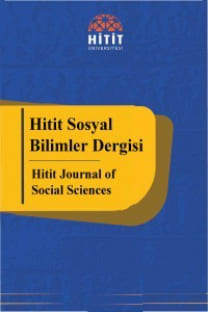İmam-ı Rabbânî’nin Mektûbât’ında İçedönük Eleştiriler
Criticism is important for the refinement and the maturation of any person or institution. Introspective criticism is more beneficial than outside criticism in the field of science. Islamic Mysticism has an extensive background of introspective criticism within Islamic science. These provide introspective critiques that are separated into two sections within Islamic mysticism. The first is the general introspective criticism which looks like a complaint. This kind of critique emerged from the third century (AH). The second type of introspective criticism is “deviation” and it is accepted as a tool for behavior and also for practices of criticism. Letters to the disciples of the Murshids contained questions from remote places which were answered. These letters are considered guides to introspective criticism. Imam Rabbani (1034/1624) is one of the murshids who educated his disciples with his letters. In this article, I will be studying on Imam Rabbani’s introspective criticism on Sufis’ ideas and practices like paradoxical expressions, in favor of the preponderance of sainthood, the acknoqledgement of halal and haram, giving importance to the miracle and khal and vajd (state), the exess on malamat (reprimand), and unauthorized guides.
Anahtar Kelimeler:
İmam Rabbani, Mektubat, İçedönük Eleştiriler
THE INTROSPECTIVE CRITICISM IN MAKTUBAT OF IMAM RABBANI AHMAD FAROQ AL-SARHANDI
Criticism is important for the refinement and the maturation of any person or institution. Introspective criticism is more beneficial than outside criticism in the field of science.Islamic Mysticism has an extensive background of introspective criticism within Islamic science. These provide introspective critiques that are separated into two sections within Islamic mysticism.The first is the general introspective criticism which looks like a complaint. This kind of critique emerged from the third century (AH). The second type of introspective criticism is “deviation” and it is accepted as a tool for behavior and also for practices of criticism.Letters to the disciples of the Murshids contained questions from remote places which were answered. These letters are considered guides to introspective criticism.Imam Rabbani (1034/1624) is one of the murshids who educated his disciples with his letters. In this article, I will be studying on Imam Rabbani’s introspective criticism on Sufis’ ideas and practices like paradoxical expressions, in favor of the preponderance of sainthood, the acknoqledgement of halal and haram, giving importance to the miracle and khal and vajd (state), the exess on malamat (reprimand), and unauthorized guides
Keywords:
Imam Rabbani, Maktubat, Introspective Criticism,
___
- AL-TAHANEVI, Muhammed A’la b. Ali Kasshaf ıstılahat Al-funun, Daru Sadr, Beirut, vol.: II. YAZICI, Tahsin, (1979), “Şath”, Islam Ansiklopedisi, MEB, Istanbul, vol.: XI.
- ABU HAZZAM, Anvar Fuad, (1993), Mu’cem Al-mustalahat Al-sufiyye, Beirut.
- ULUDAĞ, Süleyman, (1995), Tasavvuf Terimleri Sözlüğü, Marifet, Istanbul.
- CEBECIOGLU, Ethem, (1997), Tasavvuf Terimleri ve Deyimleri Sozlugu, Rehber, Ankara.
- IMAM RABBANI, Ahmad Faroq Al-Sarhandi, Al-Maktubat, trans.: Muhammed Murad Al-Munzavi Al-Maktabat Al-Muhammediyye, Istanbul.
- AL-KUSHAYRI, Abdulkerim, (1991), Kuşeyrî Risalesi, haz. Süleyman Uludag, Dergâh Yay., Istanbul.
- KARA, Mustafa, Tanımı ve Tesirleriyle Tasavvuf, Seha Neşriyat, Istanbul.
- Yayın Aralığı: Yılda 2 Sayı
- Başlangıç: 2008
- Yayıncı: Hitit Üniversitesi
Sayıdaki Diğer Makaleler
GELİR DAĞILIMI ADALETSİZLİĞİNE ÇÖZÜM ARAYIŞLARI: YİRMİ BİRİNCİ YÜZYILDA KAPİTAL
UYGULAMA ÖĞRETMENLERİNİN VE ÖĞRETMEN ADAYLARININ EPİSTEMOLOJİK İNANÇLARININ KARŞILAŞTIRILMASI
Gülgün BANGİR ALPAN, Gürcü KOÇ ERDAMAR
AVRUPALI TÜRKLER: DİN VE ENTEGRASYON
ÇEVRE SORUNSALINA DİSİLİNLERARASI BAKIŞ: SOSYAL ÇEVRE BİLİMLERİ
SOSYOLOJİK AÇIDAN FUTBOL VE PROFESYONELLİK
Ersin AFACAN, Hüseyin BAL, Hayrettin GÜMÜŞDAĞ, Gökhan ÇOBANOĞLU
AFETLERDE KAMU YÖNETİMİNİN ROLÜ VE TOPLUM TEMELLİ AFET YÖNETİMİNE DOĞRU
MADENCİLİK PROJELERİNİN ÇEVRESEL DIŞSALLIKLAR GÖZ ÖNÜNDE BULUNDURULARAK EKONOMİK DEĞERLENDİRMESİ
